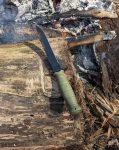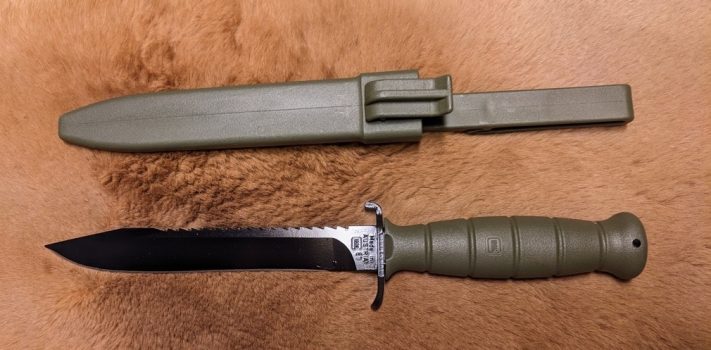Before Gaston Glock ever designed his first handgun, his company made knives and other equipment for the Austrian Army. One day in 1980, Glock was at the Austrian Ministry of Defense to talk about the sale of some of his products. While he was there, Glock overheard a conversation about the need for a new handgun design to replace the aging, World-War-II-era P38s that the Austrian Army was still using. He decided to design a handgun to meet that need. He bought samples of all the semi-auto handguns that he could find. He disassembled them, and studied how they functioned. Then he came up with an innovative design that won the Austrian Army Handgun Trials of 1982. The polymer that Glock used for making sheaths for his knives ended up becoming a major component of his handgun designs. The rest, as they say, is history.
The FM78 and FM81 field knives that Glock manufactured BG17 (“Before the Glock 17”) are still widely issued in the Austrian Army today. The difference between the two knives is that the FM78 has a flat back blade, while the FM81 has a saw back blade. The “FM” stands for “Feldmesser”, which means “field knife” in German.
Background
A couple of months ago, I tested a knife made by the KA-BAR Company. That drew my attention to the iconic Marine “Knife, Fighting Utility” that made the KA-BAR Company famous. I decided that it would be interesting to test a military field knife.
I quickly discovered that a classic KA-BAR fighting utility knife cost almost $100. Most other military field knives were similarly pricey. The Glock FM81 was a pleasant exception. I was able to order one online for only $36.20, making it a great value for a starter military field knife. Six days after I placed my order, the knife was delivered.
Overview
 The Glock FM 81 is a classic military field knife. I do not especially like it. It is too long and too awkward to be ideal for most civilian uses. The sheath is noisy and the saw back is not especially effective. But it will probably work just about as well as any other military field knife for its intended purpose. If you want to dip your toe in the waters of military field knives, the Glock FM 81 is probably a good place to start.
The Glock FM 81 is a classic military field knife. I do not especially like it. It is too long and too awkward to be ideal for most civilian uses. The sheath is noisy and the saw back is not especially effective. But it will probably work just about as well as any other military field knife for its intended purpose. If you want to dip your toe in the waters of military field knives, the Glock FM 81 is probably a good place to start.
First Impressions
The knife arrived in a somewhat battered blister package. The information on the package extolled the virtues of Glock pistols, and said virtually nothing about Glock knives.
 I cut open the blister pack, and removed the knife. As mentioned above, the sheath is made of polymer. The knife retention clip on the sheath can be somewhat difficult to disengage. I eventually learned that one effective way of disengaging the clip is to press it away from the knife with a thumb while pushing simultaneously upward on the upper and lower crossguards with the index finger and middle finger of the same hand. I also learned that if one presses inward with the finger that is on the edge side of the blade while removing the knife from the sheath in this way, one might cut their finger.
I cut open the blister pack, and removed the knife. As mentioned above, the sheath is made of polymer. The knife retention clip on the sheath can be somewhat difficult to disengage. I eventually learned that one effective way of disengaging the clip is to press it away from the knife with a thumb while pushing simultaneously upward on the upper and lower crossguards with the index finger and middle finger of the same hand. I also learned that if one presses inward with the finger that is on the edge side of the blade while removing the knife from the sheath in this way, one might cut their finger.
The 6.5-inch clip point blade is made of SAE1095 carbon steel. It comes impressively sharp. The backswedge is not sharpened, which is an advantage in those jurisdictions that define a knife with a sharpened backswedge as an illegal dagger. The blade has an electrophoretic coating that is glossier than I would prefer. The polymer handle could also profit from a little texturing to help improve grip.
The blade arrived a little oily, which is a wise precaution: SAE1095 carbon steel is not especially corrosion-resistant.
The polymer sheath seemed a little bulky, clunky, and clanky. The belt clip can accommodate belts up to 2.4 inches in width, and has a rather clever clasp to fasten it. There is a drain hole in the end of the sheath to prevent moisture from collecting inside.
Testing
I attached the knife to the belt of my work pants, and it accompanied me on my various tasks during the testing period.
 My biggest impression from my testing was that the sheath is somewhat awkward and very noisy. It seemed to always be in my way when I was trying to get into a vehicle, sit in a chair, climb a tree, or otherwise maneuver through a tight space. And whenever it came into contact with anything, it made a hollow-sounding “clunk”. I don’t know how the Austrian military can conduct any operations involving stealth when their field knife is so prone to advertise its presence so loudly. I did have occasion to use the knife for a number of different tasks throughout the testing period. These tasks included the following:
My biggest impression from my testing was that the sheath is somewhat awkward and very noisy. It seemed to always be in my way when I was trying to get into a vehicle, sit in a chair, climb a tree, or otherwise maneuver through a tight space. And whenever it came into contact with anything, it made a hollow-sounding “clunk”. I don’t know how the Austrian military can conduct any operations involving stealth when their field knife is so prone to advertise its presence so loudly. I did have occasion to use the knife for a number of different tasks throughout the testing period. These tasks included the following:
∙ Cutting a section of an old bicycle inner tube to make a band to hold a box shut. The knife sliced through the rubber effortlessly.
∙ Cutting a groove in a log. I was roasting hot dogs at our fire pit. I wanted a groove to keep the hot dog fork from rolling along the top of the log while I was rotating the fork. The root saw did a great job of cutting the groove.
∙ Cutting saplings with the root saw and small branches with the blade. I was not especially impressed with the performance of the saw or the blade for these tasks.
∙ Cutting flaps off a cardboard box so I could use the box to carry some items without the flaps getting in the way. The knife did an excellent job of cutting through cardboard.
Long Blade Versus Short Blade Knives
There are some tasks, like cutting watermelon, that are best accomplished with a longer-bladed knife. Most other tasks that require a knife are easier to accomplish with a somewhat shorter blade. It allows better control over the cutting process. This principle is best illustrated by a thought experiment: imagine trying to skin a squirrel with a machete.
Military field knives tend to be longer than most civilian field knives. This is because in addition to opening containers, preparing food, making wood shavings for starting a fire, and other camp chores, a field knife might be called upon to be used in combat. Long before the Israelite Judge Ehud used an 18-inch dagger to assassinate Eglon, King of Moab (Judges 3:12-24), it was well known that a longish blade is more effective at penetrating vital organs than a shortish blade.
I have only once ever drawn a knife for possible defensive use. I shared that experience involving an animal in an article that was published in SurvivalBlog on March 13, 2023. During that event, I would have been happy to have a knife with a longer blade.
But throughout my testing of the FM81, the longer blade was an inconvenience. It felt awkward and unnatural. I have decided that I would only be interested in carrying a longer-bladed knife under the most exceptional circumstances. If I found myself in exceptional circumstances, I would not mind carrying the FM81. But if I was carrying the FM81 into danger, I would want to carry it in a different sheath. It is my opinion that polymer is more suitable for handgun frames than knife sheaths.
SAE1095 Steel
SAE 1095 steel is a high-carbon steel composed of about 98.5% iron, 0.95% carbon, 0.4% manganese, 0.05% sulfur, and 0.04% phosphorous. It is a relatively low-cost steel that tends to be tough and wear-resistant, but has very poor corrosion resistance. It can be used in a wide range of applications from spring steel to knife blades. If treated to greater hardness, it can become somewhat brittle. When used in the highest quality blades, like certain Japanese katanas, differential hardening or differential tempering can make the edge harder while keeping the spine tougher.
For a field knife, a stainless steel might be a more practical choice than SAE1095. Preventive maintenance to resist corrosion can often be difficult under field conditions. But field knives are often made of high-carbon steel. This may be due to the common practice of buying military equipment from the lowest bidder. Military bureaucracies may at times inflict equipment on their forces that is of a lower quality than a civilian would typically select for their own use.
Conclusions
 The Glock FM 81 is a classic military field knife. It tends to be too long and awkward for most civilian uses. The sheath is noisy enough that I would not want to carry it in the dark in the vicinity of nervous trigger fingers. The saw back is not especially effective. I hope that I am never in a situation in which I need a military field knife, because I have decided that I don’t especially like them. But if I am ever in a situation in which I need to defend my life with a knife, the Glock FM81 would probably work about as well as any other military field knife in my unskilled and decidedly civilian hands.
The Glock FM 81 is a classic military field knife. It tends to be too long and awkward for most civilian uses. The sheath is noisy enough that I would not want to carry it in the dark in the vicinity of nervous trigger fingers. The saw back is not especially effective. I hope that I am never in a situation in which I need a military field knife, because I have decided that I don’t especially like them. But if I am ever in a situation in which I need to defend my life with a knife, the Glock FM81 would probably work about as well as any other military field knife in my unskilled and decidedly civilian hands.
Disclaimer
I did not receive any financial or other inducement to mention any vendor, product, or service in this article.










